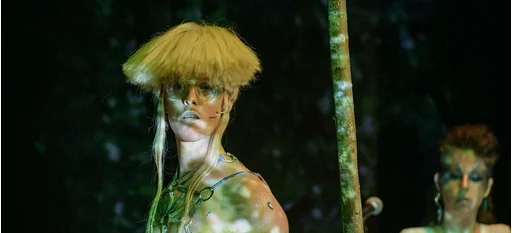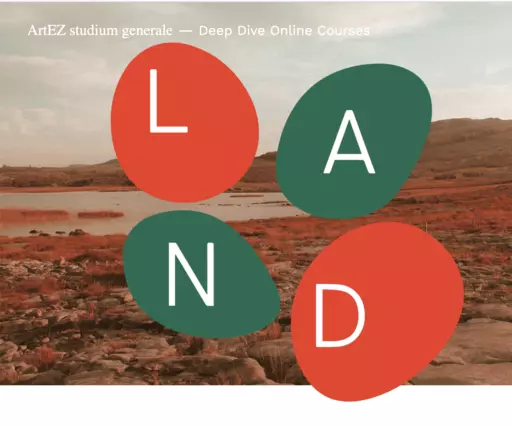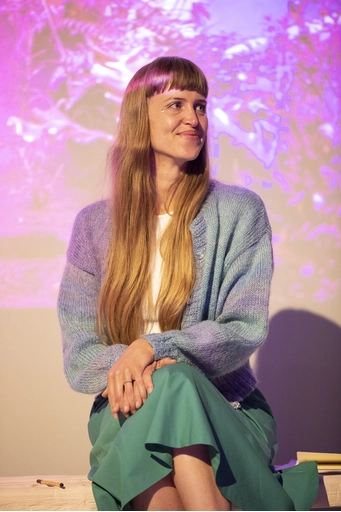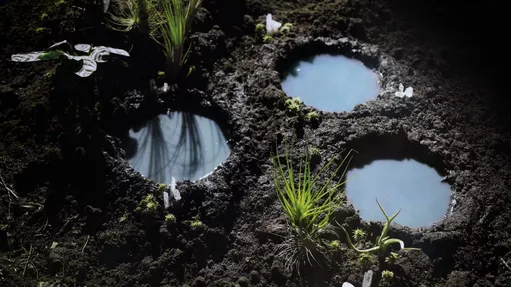
To live and die with soil
An essay by Georgia Kareola
essay by Georgia Kareola – 05 jul. 2022topic: LAND
This essay contextualizes Jasper Griepink’s solo exhibition EARTHSHRINE. EARTHSHRINE offers an eco-fictional sacred space with multi-media artworks and public gatherings inviting us to redefine our relationship with soil. This essay unpacks the exhibition’s prompt “Sensing Sacred Soils” in light of the current soil crisis, and works with critical theory on soil ecologies and new materialist thought to further our understanding of sensing as a way of relating, and soil as a complex living, multi-species assemblage with both earthly and transcendental qualities. In addition, the essay contains threads woven in from the Temple Talk between Jasper Griepink and eco-warrior Victoria McKenzie, during which they touched on notions of sacred spaces, soil communities and collctivity, storytelling, and dance as ways to connect with the land.
& Watch the Temple Talk
When walking on a warm, humid day from Eindhoven Strijp to MU Hybrid Art House, the presence of concrete in this historically industrial city can feel suffocating. A highway separates massive building blocks; old factories, new storage facilities and offices. Here and there some room is reserved for a small strip of grass, but most of the soil is hidden underneath a layer of asphalt or square pavement tiles.
Entering Jasper Griepinks’s solo-exhibition at MU (which is based in a former Philips factory) offers a sharp contrast to this stark, grey environment. At the ticket desk, anyone visiting is advised that they can touch everything in the show, and it soon becomes evident why. All works inside encourage tactile encounters. Handwoven walls of willow branches and hemp fibre mats mark the entrance to what reveals itself as the inner sanctum. The large space inside is cool, dark, and moist, reminding most of a forest at night, but one illuminated by pink and purple lighting. Dripping water merges with the sounds of one of the videos on display, resonating the rustling of leaves and birds chirping. Why not sit down on one of the big rocks and take off your shoes? Why not let your feet touch the soil?
Griepink was born in Eindhoven in 1988 and their artistic practice spans installation and performance work, writing, and teaching. They have worked with this contradiction before. In their performance and video piece first shown at Onomatopee, Ultra Ecosexual Polyamory. Permaculture ASAP (2017), a futuristic pagan performer is intimate with the trees and foliage in Eindhoven’s city center. 1) A letter accompanying the video provides an anti-capital, pro- ecosexualpermacultural manifesto, with tongue-in-cheek commands, like “strap on a crystal, lick a leaf. 2) Griepink is also known for creating art installations that function as sacred spaces, such as Grove 2.0 – Kapel van de Wilde Wijsheid (2017) at Lustwarande, a geodesic greenhouse facilitating contemplation and a connection with the earth. 3)
Entering Jasper Griepinks’s solo-exhibition at MU (which is based in a former Philips factory) offers a sharp contrast to this stark, grey environment. At the ticket desk, anyone visiting is advised that they can touch everything in the show, and it soon becomes evident why. All works inside encourage tactile encounters. Handwoven walls of willow branches and hemp fibre mats mark the entrance to what reveals itself as the inner sanctum. The large space inside is cool, dark, and moist, reminding most of a forest at night, but one illuminated by pink and purple lighting. Dripping water merges with the sounds of one of the videos on display, resonating the rustling of leaves and birds chirping. Why not sit down on one of the big rocks and take off your shoes? Why not let your feet touch the soil?
Griepink was born in Eindhoven in 1988 and their artistic practice spans installation and performance work, writing, and teaching. They have worked with this contradiction before. In their performance and video piece first shown at Onomatopee, Ultra Ecosexual Polyamory. Permaculture ASAP (2017), a futuristic pagan performer is intimate with the trees and foliage in Eindhoven’s city center. 1) A letter accompanying the video provides an anti-capital, pro- ecosexualpermacultural manifesto, with tongue-in-cheek commands, like “strap on a crystal, lick a leaf. 2) Griepink is also known for creating art installations that function as sacred spaces, such as Grove 2.0 – Kapel van de Wilde Wijsheid (2017) at Lustwarande, a geodesic greenhouse facilitating contemplation and a connection with the earth. 3)
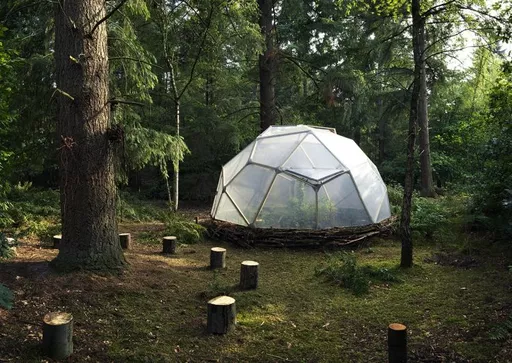

EARTHSHRINE, like these previous works, is partly inspired by the Celtic druids, who traditionally gathered at clearings in the forest to study the teachings of nature. While taking inspiration from these ancient practices, the world of EARTHSHRINE simultaneously catapults the narrative into an eco-fictional future. Mystical aliens in the Matthew Barney-esque video Dirty play out their first-ever encounter with soil, while the suggestion of a spaceship landed in the space – a raised, oval structure populated by plants, mist, and a water sculpture — disrupts the notion of an ancient, sacred gathering. By introducing spaceships and alien beings, Griepink uses the sciencefiction method of estrangement. We are placed at a distance from our world and asked to see it anew. In transporting the viewer, these works also prompt to ask questions. Questions about the future. Questions about soil.
The descriptive claim of the exhibition, Sensing Sacred Soils, connects soil to notions of relationality and the sacred. Sensing is a way of relating with the world, and by inviting people to engage on a sensorial level, Griepink encourages us to (re)connect with soil. Relating with soil is relevant because we currently live in a soil crisis. A recent report by IPBES showed that currently 33% of soils on the earth are degraded, meaning they are unable to produce human food. 4) With the current rate of soil exploitation, the expectation is that 99% of soils could become degraded by 2050. 5) Since all human food, except sustenance salvaged from the ocean, originates in soil it is urgent to address this degradation, even just for the survival chances of the human species.
The same report mentions how the rate of global change in nature during the past 50 years is unprecedented in human history. The largest driver of change is the way in which humans have made use of the land and sea, by for example industrializing and scaling practices like agriculture and fishing. The second largest is the way in which other, nonhuman organisms have been exploited. At this moment, 75% of the land surface has been significantly altered by humans for the purpose of agriculture, animal husbandry, and industry. 6)
Since there were animals, soil has always been a resource, providing food and building materials for mammals, birds, reptiles, and invertebrates. Human agricultural practices have exhausted soils across the world long before industrialization. 7) But since the industrial revolution, in industrialized parts of the world, the issues accompanying the excessive exploitation of land were propelled to another level. The human-soil relationship became one in which humans use oil almost exclusively for the production of economic value, and this over-focus on productivity changed agricultural practices. Soil became to represent money.
The soil crisis, like the climate crisis, is a crisis of relationality. How we relate with soil and other nonhuman kin, matters in whether we contribute to a more degraded, or a more liveable, flourishing world. How can we transform the relationships currently rooted in extraction and exploitation, to ones based on mutual respect, collaboration, and care? On joy, compassion, and pleasure?
Environmental justice and ecofeminism are some of the practices that address these relational distortions, and the work done by people in these fields is aimed at shifting the focus from a productivist to a regenerative way of relating. Both practices are aimed at restoring the relationships between humans and nonhumans, the living and nonliving, the material and the immaterial. EARTHSHRINE equally offers a proposition to restore the human-soil relationship, through its audiovisual stories of speculative fiction, its public program including a Temple Talk and an Earth Rave, and by quite literally putting a patch of soil on display in a way that reminds of the floor-based earth installations by herman de vries. Here, a paradox also becomes apparent, as soil is somewhat dismembered when placed in an exhibition space. This is a representational problem common in art, as we are looking at a thing out of context, not at the thing itself. Soil on the floor at MU is a metaphorical object, with a symbolic and narrative function. Soil becomes a symbol that represents all soil.
Jasper Griepink explored this symbolic quality of soil in a collaborative ritual performance with Victoria McKenzie, where those who participated were encouraged to hold the soil from MU’s floor in their hands and thank it for all it (soil) continues to provide. The experience brought tears to peoples’ eyes, showing the affective power of representation. The thanked soil was then collected in dedicated bowl before earthworms and various species of mycorrhizal fungi were added, and with that, life was introduced.
Key to restoring the human-soil relationship, is understanding soil not as an inert substance, but as a complex, living, multi-species world. Soil consists of nonliving components like sands, mud, rocks, and minerals, as well as living creatures like earthworms, plant species, and fungal internets. As Jasper Griepink and Victoria McKenzie pointed out in their Temple Talk, there are many different types of soil, inhabited by different plant and animal species, which exchange resources in complex trade relationships. 8) In relating with soil, we are not merely relating with a resource providing food and building materials for houses, nests, or earthshrines. We are interacting with webs of relational beings. Soil ecologies.
Biologist and ecofeminist philosopher Donna Haraway points out how “nothing makes itself; nothing is really autopoietic or self-organizing.” 9) Every-one and every-thing is in a constant process of being and making with, a process Haraway defines as sympoiesis. She further observes how the drives of sensual curiosity, insatiable hunger and irresistible attraction are the vital motor of living and dying on earth, and how “critters interpenetrate one another, loop around and through one another, eat each other, get indigestion, and partially digest and partially assimilate one another, and thereby establish sympoetic arrangements that are otherwise known as cells, organisms, and ecological assemblages.” 10) Soils are ecological assemblages, complex systems consisting of living organisms eating, digesting, metabolizing. Soils are, in Haraway’s words, unruly.
This metabolic aspect of soils also brings us to their more mystical qualities. Soils provide life, in the form of food that sustains bodies. Bodies eat seeds, fruits and vegetables born from soils, digest these to gain energy, and expel what they don’t need so their excrement again becomes soil. Similarly soils take life. We bury our dead in the soil. In soils, dead bodies become subject to a wild and unruly, multi-species project of decay. Through decomposition bodies become food for other bodies. Soils embody death and life, and all stages in between. Additionally, soils provide not only food in the most basic sense, but also medicinal and entheogenic plants, which, when ingested give access to healing qualities and more supernatural knowledge.
The power to give and take life is something that is often ascribed to more transcendent forces. And equally, the transmission of truth is often seen as “in the hands of the gods”. In soils these metaphysical relationships become material, and as such, soils could be seen as not merely complex living systems, but also as spiritual ones. Maybe we don’t have to look so far, and maybe not up, but down, in order to find the sacred, as soils contain knowledges about the origins and endings of life, and about life itself.
The descriptive claim of the exhibition, Sensing Sacred Soils, connects soil to notions of relationality and the sacred. Sensing is a way of relating with the world, and by inviting people to engage on a sensorial level, Griepink encourages us to (re)connect with soil. Relating with soil is relevant because we currently live in a soil crisis. A recent report by IPBES showed that currently 33% of soils on the earth are degraded, meaning they are unable to produce human food. 4) With the current rate of soil exploitation, the expectation is that 99% of soils could become degraded by 2050. 5) Since all human food, except sustenance salvaged from the ocean, originates in soil it is urgent to address this degradation, even just for the survival chances of the human species.
The same report mentions how the rate of global change in nature during the past 50 years is unprecedented in human history. The largest driver of change is the way in which humans have made use of the land and sea, by for example industrializing and scaling practices like agriculture and fishing. The second largest is the way in which other, nonhuman organisms have been exploited. At this moment, 75% of the land surface has been significantly altered by humans for the purpose of agriculture, animal husbandry, and industry. 6)
Since there were animals, soil has always been a resource, providing food and building materials for mammals, birds, reptiles, and invertebrates. Human agricultural practices have exhausted soils across the world long before industrialization. 7) But since the industrial revolution, in industrialized parts of the world, the issues accompanying the excessive exploitation of land were propelled to another level. The human-soil relationship became one in which humans use oil almost exclusively for the production of economic value, and this over-focus on productivity changed agricultural practices. Soil became to represent money.
The soil crisis, like the climate crisis, is a crisis of relationality. How we relate with soil and other nonhuman kin, matters in whether we contribute to a more degraded, or a more liveable, flourishing world. How can we transform the relationships currently rooted in extraction and exploitation, to ones based on mutual respect, collaboration, and care? On joy, compassion, and pleasure?
Environmental justice and ecofeminism are some of the practices that address these relational distortions, and the work done by people in these fields is aimed at shifting the focus from a productivist to a regenerative way of relating. Both practices are aimed at restoring the relationships between humans and nonhumans, the living and nonliving, the material and the immaterial. EARTHSHRINE equally offers a proposition to restore the human-soil relationship, through its audiovisual stories of speculative fiction, its public program including a Temple Talk and an Earth Rave, and by quite literally putting a patch of soil on display in a way that reminds of the floor-based earth installations by herman de vries. Here, a paradox also becomes apparent, as soil is somewhat dismembered when placed in an exhibition space. This is a representational problem common in art, as we are looking at a thing out of context, not at the thing itself. Soil on the floor at MU is a metaphorical object, with a symbolic and narrative function. Soil becomes a symbol that represents all soil.
Jasper Griepink explored this symbolic quality of soil in a collaborative ritual performance with Victoria McKenzie, where those who participated were encouraged to hold the soil from MU’s floor in their hands and thank it for all it (soil) continues to provide. The experience brought tears to peoples’ eyes, showing the affective power of representation. The thanked soil was then collected in dedicated bowl before earthworms and various species of mycorrhizal fungi were added, and with that, life was introduced.
Key to restoring the human-soil relationship, is understanding soil not as an inert substance, but as a complex, living, multi-species world. Soil consists of nonliving components like sands, mud, rocks, and minerals, as well as living creatures like earthworms, plant species, and fungal internets. As Jasper Griepink and Victoria McKenzie pointed out in their Temple Talk, there are many different types of soil, inhabited by different plant and animal species, which exchange resources in complex trade relationships. 8) In relating with soil, we are not merely relating with a resource providing food and building materials for houses, nests, or earthshrines. We are interacting with webs of relational beings. Soil ecologies.
Biologist and ecofeminist philosopher Donna Haraway points out how “nothing makes itself; nothing is really autopoietic or self-organizing.” 9) Every-one and every-thing is in a constant process of being and making with, a process Haraway defines as sympoiesis. She further observes how the drives of sensual curiosity, insatiable hunger and irresistible attraction are the vital motor of living and dying on earth, and how “critters interpenetrate one another, loop around and through one another, eat each other, get indigestion, and partially digest and partially assimilate one another, and thereby establish sympoetic arrangements that are otherwise known as cells, organisms, and ecological assemblages.” 10) Soils are ecological assemblages, complex systems consisting of living organisms eating, digesting, metabolizing. Soils are, in Haraway’s words, unruly.
This metabolic aspect of soils also brings us to their more mystical qualities. Soils provide life, in the form of food that sustains bodies. Bodies eat seeds, fruits and vegetables born from soils, digest these to gain energy, and expel what they don’t need so their excrement again becomes soil. Similarly soils take life. We bury our dead in the soil. In soils, dead bodies become subject to a wild and unruly, multi-species project of decay. Through decomposition bodies become food for other bodies. Soils embody death and life, and all stages in between. Additionally, soils provide not only food in the most basic sense, but also medicinal and entheogenic plants, which, when ingested give access to healing qualities and more supernatural knowledge.
The power to give and take life is something that is often ascribed to more transcendent forces. And equally, the transmission of truth is often seen as “in the hands of the gods”. In soils these metaphysical relationships become material, and as such, soils could be seen as not merely complex living systems, but also as spiritual ones. Maybe we don’t have to look so far, and maybe not up, but down, in order to find the sacred, as soils contain knowledges about the origins and endings of life, and about life itself.
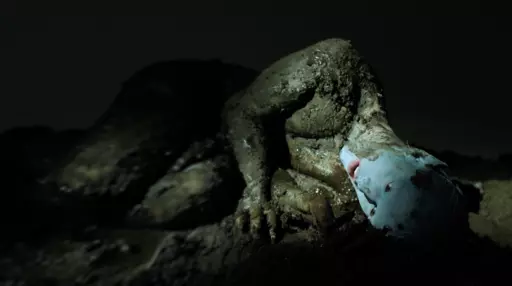

Acknowledging this cyclical quality of soils and understanding our participation in its process of giving and receiving, while admitting the mysteries contained within, can inform our ways to relate. These more ineffable qualities of soils are also touched on in Griepink’s video EARTH(hurt) (2021), in which an alien being, covered in mud, suffers. In what feels like an entheogenic revelation, the protagonist appears to feel the pain of the earth, possibly inflicted by the violence of humans, while muttering words of respect for earth, which in many ways equals soils. Earth is seen as a teacher; she teaches us everything.
In Dirty (2022), the other video work shown in this exhibition, two purple-blue alien elfs come to earth and experience soil for the first time. While rhythmically moving around one of the big rocks also on display in the show, they sing of “a time before dirt was dirty.” Their chant echoes environmental activist George Monbiot, who headlined in 2015 that “we’re treating soil like dirt” and “it’s a fatal mistake, as our lives depend on it.” 11) Whereas Monbiot spoke about soil neglect in relation to industrial farming and its subsequent planetary depletion, the alien beings in Dirty address this issue more indirectly by bringing attention to the semiotic confusion of calling dirt dirty. In doing this, they direct the gaze of the audience to the more positive, mysterious, and sensual qualities of soil, before they rub each other in mud and things actually get “dirty”.
In Dirty (2022), the other video work shown in this exhibition, two purple-blue alien elfs come to earth and experience soil for the first time. While rhythmically moving around one of the big rocks also on display in the show, they sing of “a time before dirt was dirty.” Their chant echoes environmental activist George Monbiot, who headlined in 2015 that “we’re treating soil like dirt” and “it’s a fatal mistake, as our lives depend on it.” 11) Whereas Monbiot spoke about soil neglect in relation to industrial farming and its subsequent planetary depletion, the alien beings in Dirty address this issue more indirectly by bringing attention to the semiotic confusion of calling dirt dirty. In doing this, they direct the gaze of the audience to the more positive, mysterious, and sensual qualities of soil, before they rub each other in mud and things actually get “dirty”.
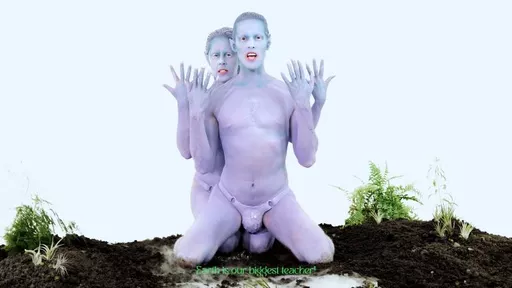

This semi-pornographic encounter with dirt evolves the work done in Ultra Ecosexual Polyamory. Permaculture ASAP (2017). The beings here are more ethereal, less human, and more future; the exchange with nature more explicitly erotic and fantastical, its spiritual position more overtly critical. Post mud-rub, the aliens “pray to the soil god” and one of them chants “I won’t be praying with my hands up” alluding to the idea that the sacredness of soil is situated not in some transcendent or imagined being in the sky, but in the soils themselves.
This inversion was an important reason for Griepink to start working with soil. They mentioned how “acknowledging that we are always with, and on the sacred is a radical move away from the idea of a sky god, from deity as far away. The idea that God is in the heavens is dominant in patriarchal religions, and in European history the sacred has been made inaccessible by popes and priests, creating dogma, politics and power. Making earth sacred destroys this notion. It makes the sacred something common which can be shared, and which connects all of us like the fungi in the undercroft connecting the plants and trees.”12)
The visual and narrative exaggeration in Dirty can also be considered radical, as a semiotic operation. Arguably the most banal thing on earth (earth itself) is connected to the most ephemeral and transcendent (god), while an affective quality (worship) is activated through spiritual theatrics. In this, Griepink’s work distinguishes itself from other appearances of soil in the contemporary art context, like Walter de Maria’s Earth Room (1977) or Olafur Eliason’s Riverbed (2014). Griepink does not merely display the earth and leave the interpretation to the eyes of the beholder, but introduces archetypal personas, aliens, soil priestesses, and divas to enchant, enliven, and activate the matter.
When discussing the notion of the sacred with Victoria McKenzie, they expressed how to them, the sacred is not per se found in architectural structures or incense, but is something that can be activated through storytelling or ritual. It is the storytelling that transforms spaces. Similarly, sacred experiences can be accessed (and choreographed) through collectivity and dance, (earth) raves, and rituals. It is these alternate states of consciousness, moments of euphoria, or otherwise deepened emotion, that Griepink introduces into the art space. This enables a ritualistic experience, even just in the classical sense of cultural anthropologist Victor Turner, who sees rituals “as essentially life-enhancing ludic experiences, a chance to step outside social structure [and] even to challenge that structure from within a ritually-created community.” 13)
Ritual seen in this way, can thus help to challenge the social structures and their practices of human-soil relating, just as the framework of intersectional movements like ecofeminism and climate justice can help us redefine our relationship with soil. Chelsea Power, whose thesis on Multispecies Ecofeminism can be read at the reading table at MU, describes ecofeminism as “a movement that understands the Earth and nonhuman beings as alive, as having agency, as being responsive and invariably interconnected.”14)
These movements integrate the, in some cultures ancient, understanding that everything is connected and that we (humans) are part of the web of life — not the ones in charge — into the academic discourse. This is a step towards challenging, and hopefully transforming the socioeconomic structures and social relations that are at the root of capitalist, colonial, patriarchal, and anthropocentric practices, and human-soil relationships based on extraction and exploitation. If we understand soil as something that gives, but also takes life — something that gives and takes our lives — and if we acknowledge and embody that we are in a constant process of making-with, a process of living and dying with soil, we may begin to transform our relationship with this extraordinary, possibly sacred, multi-species world.15)
EARTHSHRINE was on show at MU from 13 May till 26 June 2022. Watch the exhibition video in which Jasper Griepink tells us all about his show, check out the images of the opening and the special events or watch the Temple Talk with Jasper Griepink, Victoria McKenzie and Georgia Kareola.
This inversion was an important reason for Griepink to start working with soil. They mentioned how “acknowledging that we are always with, and on the sacred is a radical move away from the idea of a sky god, from deity as far away. The idea that God is in the heavens is dominant in patriarchal religions, and in European history the sacred has been made inaccessible by popes and priests, creating dogma, politics and power. Making earth sacred destroys this notion. It makes the sacred something common which can be shared, and which connects all of us like the fungi in the undercroft connecting the plants and trees.”12)
The visual and narrative exaggeration in Dirty can also be considered radical, as a semiotic operation. Arguably the most banal thing on earth (earth itself) is connected to the most ephemeral and transcendent (god), while an affective quality (worship) is activated through spiritual theatrics. In this, Griepink’s work distinguishes itself from other appearances of soil in the contemporary art context, like Walter de Maria’s Earth Room (1977) or Olafur Eliason’s Riverbed (2014). Griepink does not merely display the earth and leave the interpretation to the eyes of the beholder, but introduces archetypal personas, aliens, soil priestesses, and divas to enchant, enliven, and activate the matter.
When discussing the notion of the sacred with Victoria McKenzie, they expressed how to them, the sacred is not per se found in architectural structures or incense, but is something that can be activated through storytelling or ritual. It is the storytelling that transforms spaces. Similarly, sacred experiences can be accessed (and choreographed) through collectivity and dance, (earth) raves, and rituals. It is these alternate states of consciousness, moments of euphoria, or otherwise deepened emotion, that Griepink introduces into the art space. This enables a ritualistic experience, even just in the classical sense of cultural anthropologist Victor Turner, who sees rituals “as essentially life-enhancing ludic experiences, a chance to step outside social structure [and] even to challenge that structure from within a ritually-created community.” 13)
Ritual seen in this way, can thus help to challenge the social structures and their practices of human-soil relating, just as the framework of intersectional movements like ecofeminism and climate justice can help us redefine our relationship with soil. Chelsea Power, whose thesis on Multispecies Ecofeminism can be read at the reading table at MU, describes ecofeminism as “a movement that understands the Earth and nonhuman beings as alive, as having agency, as being responsive and invariably interconnected.”14)
These movements integrate the, in some cultures ancient, understanding that everything is connected and that we (humans) are part of the web of life — not the ones in charge — into the academic discourse. This is a step towards challenging, and hopefully transforming the socioeconomic structures and social relations that are at the root of capitalist, colonial, patriarchal, and anthropocentric practices, and human-soil relationships based on extraction and exploitation. If we understand soil as something that gives, but also takes life — something that gives and takes our lives — and if we acknowledge and embody that we are in a constant process of making-with, a process of living and dying with soil, we may begin to transform our relationship with this extraordinary, possibly sacred, multi-species world.15)
EARTHSHRINE was on show at MU from 13 May till 26 June 2022. Watch the exhibition video in which Jasper Griepink tells us all about his show, check out the images of the opening and the special events or watch the Temple Talk with Jasper Griepink, Victoria McKenzie and Georgia Kareola.
Jasper Griepink talks about the exhibition at MU.
References
1) www.jaspergriepink.nl/Ecopoly.html
2) Ibidem.
3) www.lustwarande.org/en/archive/artists/jasper-griepink
4) ipbes.net. IPBES is the Intergovernmental Science-Policy Platform on Biodiversity and Ecosystem Services. I am thankful to David W. Janzen for making me aware of their work.
5) Ibidem.
6) Ibidem.
7) Hillel, Daniel. Out of the Earth: Civilization and the Life of the Soil. Berkeley: University of California Press,1992. In: Puig de la Bellacasa, María. Matters of Care : Speculative Ethics in More Than Human Worlds. Minneapolis: University of Minnesota Press, 2017. Print. p. 172
8) The Temple Talk took place at MU on 26 May 2022
9) Haraway, Donna Jeanne. Staying with the Trouble : Making Kin in the Chthulucene. Durham: Duke University Press, 2016. Print. p. 58.
10) Ibidem.
11) Monbiot, George, “We’re treating soil like dirt. It’s a fatal mistake, as our lives depend on it.” The Guardian, 25 March 2015.
12) Voice memo by Jasper Griepink, 15 June 2022.
13) Lyons, Harriet D. “Catherine Bell, Ritual Theory, Ritual Practice.” New York: Oxford University Press, 1992.
14) Power, Chelsea, Multispecies ecofeminism: ecofeminist flourishing in the twenty-first century, Bachelor of Arts, University of Victoria, 2016.
15) I am thankful for the comments on an earlier version of this essay by Misha Kakabadze, Carsten Goertz, Jasper Griepink, and Angelique Spaninks.
2) Ibidem.
3) www.lustwarande.org/en/archive/artists/jasper-griepink
4) ipbes.net. IPBES is the Intergovernmental Science-Policy Platform on Biodiversity and Ecosystem Services. I am thankful to David W. Janzen for making me aware of their work.
5) Ibidem.
6) Ibidem.
7) Hillel, Daniel. Out of the Earth: Civilization and the Life of the Soil. Berkeley: University of California Press,1992. In: Puig de la Bellacasa, María. Matters of Care : Speculative Ethics in More Than Human Worlds. Minneapolis: University of Minnesota Press, 2017. Print. p. 172
8) The Temple Talk took place at MU on 26 May 2022
9) Haraway, Donna Jeanne. Staying with the Trouble : Making Kin in the Chthulucene. Durham: Duke University Press, 2016. Print. p. 58.
10) Ibidem.
11) Monbiot, George, “We’re treating soil like dirt. It’s a fatal mistake, as our lives depend on it.” The Guardian, 25 March 2015.
12) Voice memo by Jasper Griepink, 15 June 2022.
13) Lyons, Harriet D. “Catherine Bell, Ritual Theory, Ritual Practice.” New York: Oxford University Press, 1992.
14) Power, Chelsea, Multispecies ecofeminism: ecofeminist flourishing in the twenty-first century, Bachelor of Arts, University of Victoria, 2016.
15) I am thankful for the comments on an earlier version of this essay by Misha Kakabadze, Carsten Goertz, Jasper Griepink, and Angelique Spaninks.
related content
people – 16 dec. 2020
Jasper Griepink
news – 13 dec. 2021
LAND
refered to from:
